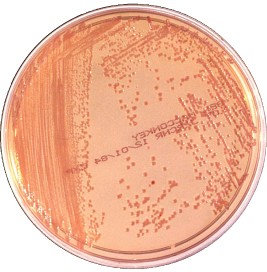Plants in the desert-adapted families Cactacea (cactus) and Euphorbia (euphorbs) share many of the same physical characteristics, such as succulent stems that store water and CAM photosynthesis, but they do not share a recent common ancestor. This evidence suggests that these families are an example of
A. vestigial structures.
B. homologous structures.
C. divergent evolution.
D. convergent evolution.
Answer: D
You might also like to view...
What method was used to inoculate the plate shown here? CDC
CDC
A. Swab plate B. Pour plate C. Streak plate D. Spread plate
What enables a PCR-amplified gene to be inserted into a cloning vector?
a. The PCR reaction adds sticky ends onto the amplified DNA, allowing ligation to a cloning vector. b. Restriction enzyme sites are added to the 5? ends of both primers; therefore, digestion of the PCR-amplified gene allows ligation to a cloning vector cut with the same restriction enzyme. c. The PCR-amplified gene is sequenced to locate restriction sites in order to determine which restriction enzymes to use for cloning. d. The PCR-amplified gene is cut with one restriction enzyme, then ligated to a cloning vector cut by a different restriction enzyme. e. The cloning vector is added to the PCR reaction, and once the gene is amplified, it immediately ligates to the cloning vector.
Formation of a tetraploid plant from two different diploid parental species of plants is an example of
A. extinction. B. adaptive radiation. C. punctuated equilibrium. D. gradualism. E. a prezygotic barrier to evolution.
The difference in the appearance of the male and the
female is known as a. polymorphism. b. sexual dimorphism. c. the dioecious condition. d. sexual selection. e. a primary sexual characteristic.